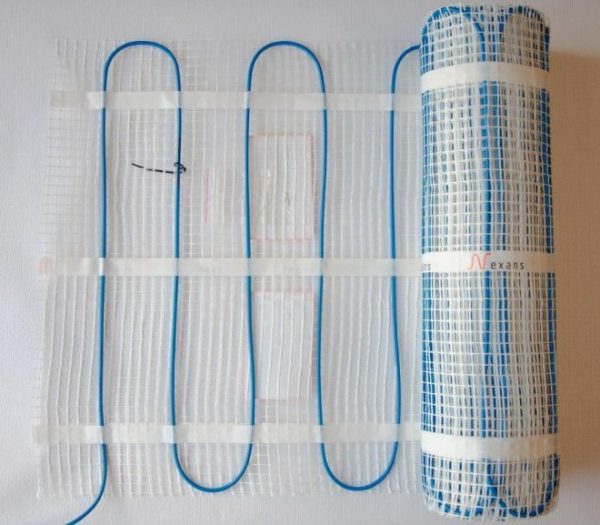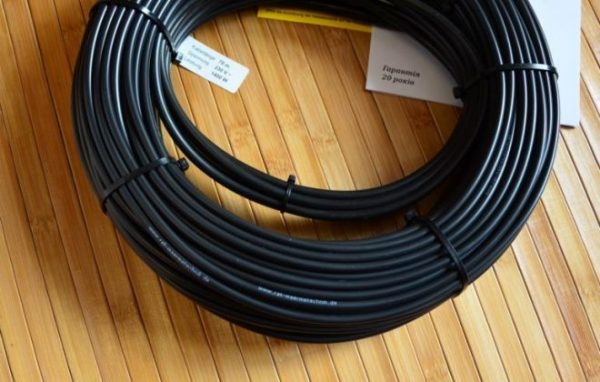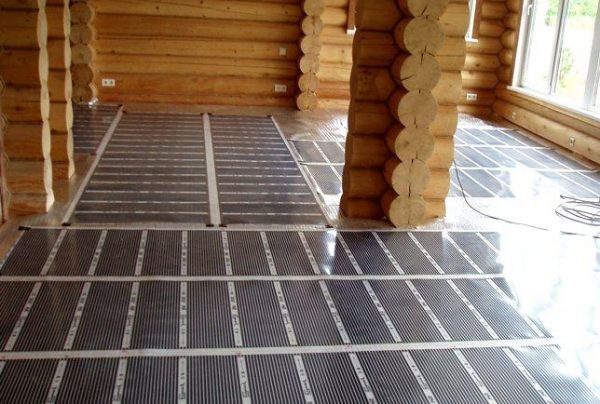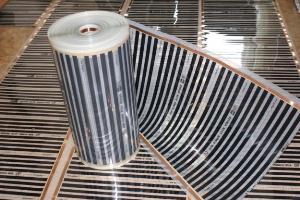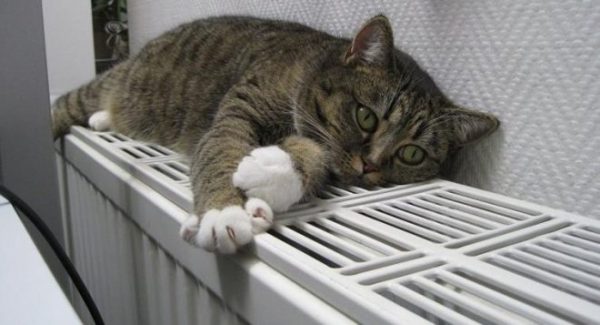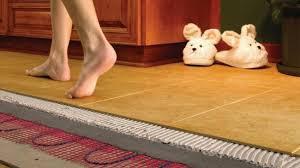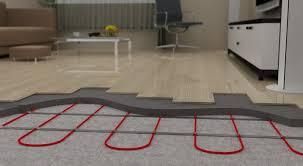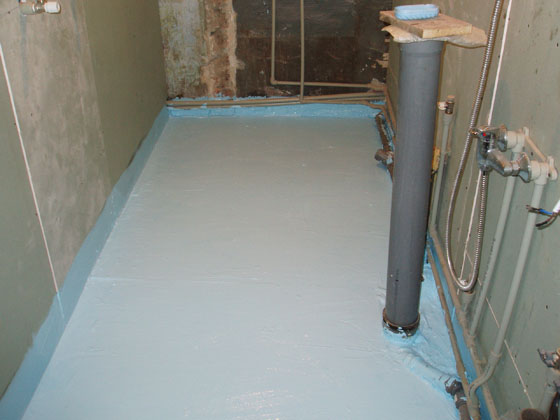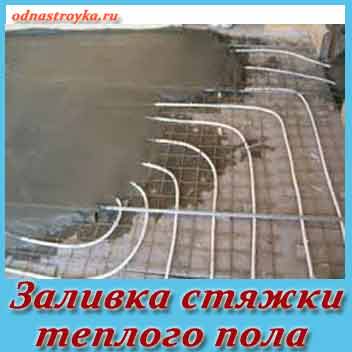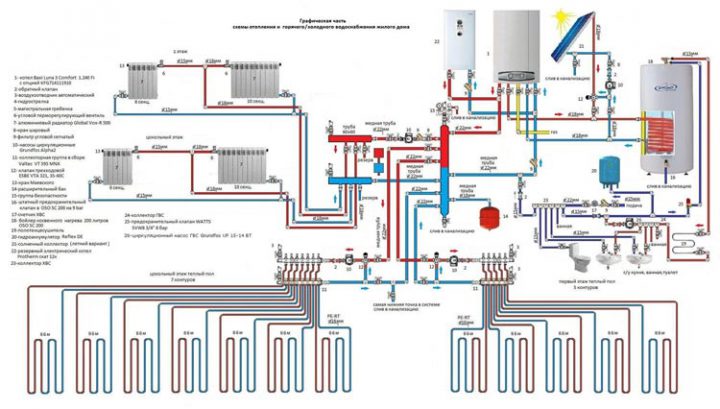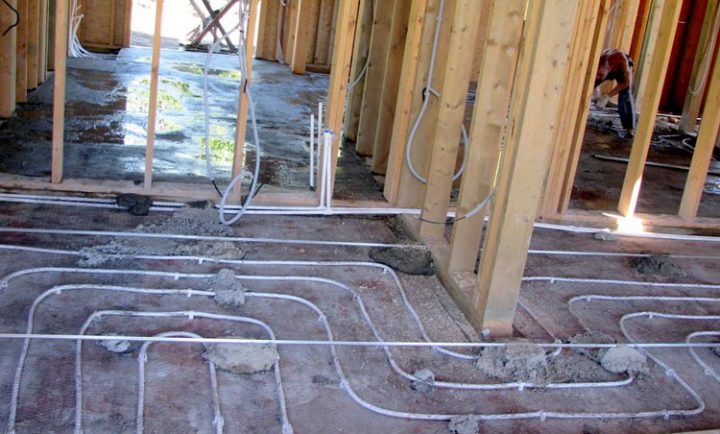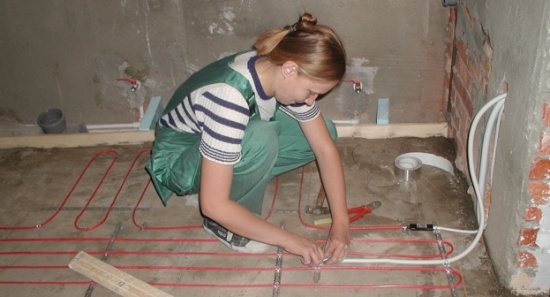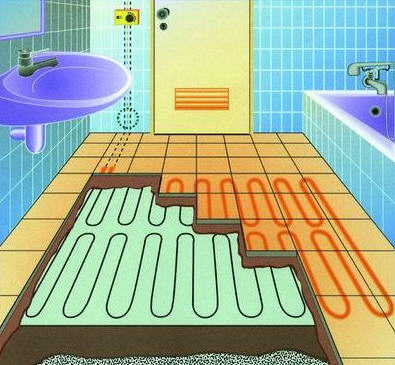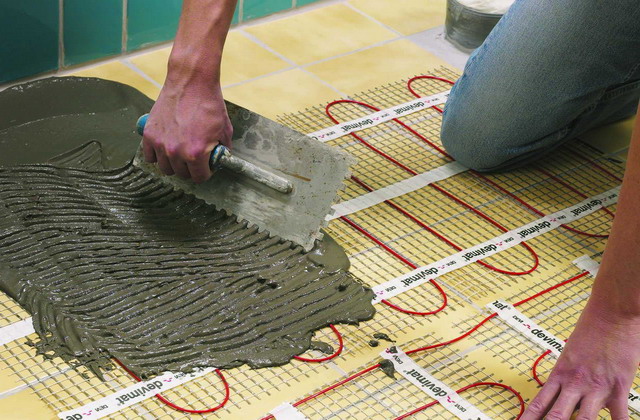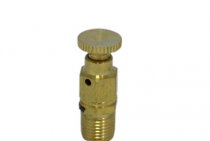Types of warm floors
Underfloor heating systems can be divided according to the type of coolant, into water and electric. Electric are divided into mats, cable and film. Water can be classified depending on the type of energy source used - gas, solid fuel and electricity.
It makes sense to use water heaters in private homes, as the main heating of large areas, from 70 to 100 square meters. The disadvantages of water heaters include the fact that they require maintenance (for example, so that the water in the pipes does not freeze in winter), installation complexity and high cost all equipment.
In an apartment of a multi-storey building, with a total area of up to 50-70 square meters. meters, electric floor heating is more preferable, due to the ease of installation and the minimum rise in the height of the screed.
If with water everything is more or less clear, then we will dwell on electric ones in more detail.
Heating mats
When talking about electric underfloor heating, in 80% of cases they mean exactly heating mats. Mats are most often used for floor heating devices under tiles or under laminate.
Their distinctive feature and advantage is that they practically do not require raising the floor level and can be integrated directly into the tile adhesive, in the case of tiles, or a thin layer of self-levelling compound, in the case of laminate. The maximum height to which the floor level rises in both cases does not exceed 5mm. Also, due to the fact that the mats are located closer to the floor surface, the heated floor based on mats heats up faster. The disadvantage is the relatively high price.
heating cable
As well as mats, it is used for floor heating under tiles and laminate, but unlike mats, it requires 3 to 5 centimeters of cement screed above itself. Cable-based floor heating is quite inert, that is, it heats up for a very long time and cools down for a long time, since it needs to warm up a fairly thick layer of screed. When using this option, it will not be possible to turn it on and off as needed, since the heating time can be from 3-4 to 8-12 hours. You can get acquainted with the prices for heating cable from different manufacturers and get additional information about this type of floor heating on the Heating-Systems website. There are two most appropriate ways to use this option:
- Turn on in the fall and turn off in the spring.
- Use a two-rate meter. That is, try to heat up to the maximum at night, use a reduced electricity tariff, and turn it off during the day.
On the positive side, we can note the cheapness of this option.
Film underfloor heating (another name is infrared)
This option is most often used for the so-called "dry installation" under wooden coatings. A distinctive feature of this option is the ability to use it without pouring any mortar, cement screed or tile adhesive. That is, unlike the previous two, this option can work in air, without the risk of failure due to overheating. At first glance, you might think that this is the ideal solution. But, unfortunately, this option has significant drawbacks, namely:
- More difficult to install than cable or mats.
- Does not have a ground loop.
- It is not advisable to use under tiles due to the fact that the film impairs the adhesion of the tile adhesive to the concrete base. As a result, we have the risk of cracking tiles.
The device of the rod heating floor in the bathroom
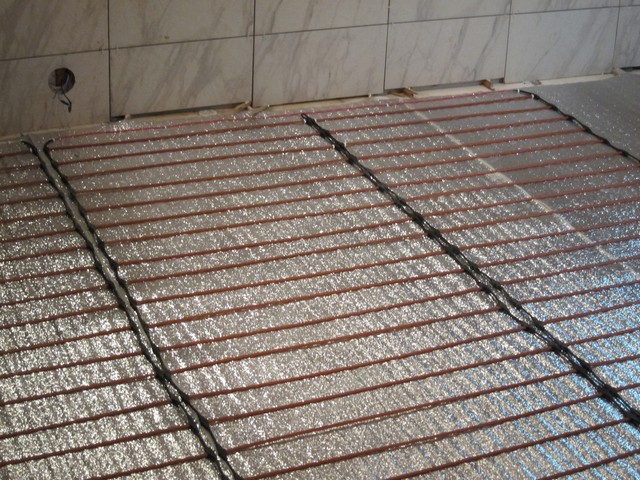
Preparatory work. It is necessary to level and clean the surface of the subfloor;
A heat reflective layer is laid. At this stage, it is already necessary to decide where the thermostat will be installed;
The flooring of the thermomats of the rod heater is being carried out. You need to start laying from the side of the thermostat. It should be done so that in the final result the rods do not touch each other;
Thermomats are fixed to the surface with adhesive tape;
The thermostat is connected
It is important for safety reasons not to forget to turn off the power supply;
You can lay a cement-sand screed or lay ceramic tiles directly on the heating elements using tile adhesive;
It is possible to start the work of the infrared floor only after the screed and tile adhesive have completely cured.
Electric underfloor heating in the bathroom will provide a comfortable stay indoors
When doing its own laying, it is important to observe safety precautions, especially when working with electricity.
In addition, it is necessary to carefully adhere to the technology of work and pay special attention to the choice of high-quality materials. In this case, the warm floor will last a long time and effectively.
Underfloor heating systems, popular with many people, are now being installed in more than just the main living areas. For example, underfloor heating in the bathroom can significantly increase the level of comfortable living throughout the home, reducing humidity and maintaining the air temperature at the proper level.
Considering that tiles are used as a finishing material in many bathrooms and bathrooms, it is in these rooms that the use of an additional source of heating will be very useful. Two types of underfloor heating are used in bathrooms: water and electric underfloor heating in the bathroom.
The owners of apartments give the greatest preference to the second option - infrared (electric) floor heating. To a greater extent, its popularity is due to the ease of installation of the structure and its further operation.
Infrared bathroom floor heating refers to an electric heating system based on heating mats. These mats are a textile base in which heating elements are embedded. With the help of a thermostat, you can easily set the required temperature for underfloor heating.
Water heated floor under the bathroom is also one of the underfloor heating systems of the house. Their distinguishing feature during installation is the use of hot water as a heat source in polymer pipes located under the floor of a bathroom or toilet. This method of floor heating is in most cases used in country cottages and houses.
In addition, the finished structure raises the height of the floor by only 4 mm. A screed with a water floor in the bathroom, as a rule, raises the overall level of the floor by about 8-10 cm. This, of course, is not very convenient, so this feature can be safely attributed to the disadvantages of this type of structure. But at the same time, a water heated floor in the bathroom is much more economical than an electric option.
Why do you need a warm floor if you have a cat and batteries
Underfloor heating provides many advantages over traditional systems. First of all, this is an incomparable feeling of comfort, which comes from soft, uniform heating, spilled over the entire area of the room. No other type of heating will give you that feeling of walking barefoot on heated tiles, after a bath or a pleasant shower, on a cold winter evening. Here it is rather necessary to raise the question: “Why do we need traditional types of heating if there is a warm floor?”.
In addition to the feeling of additional comfort, which is subjective, underfloor heating provides other more specific and pragmatic benefits. Let's take a closer look at some of them below.
Main heating
Yes, electric underfloor heating can also be used as main heating. In this case, this is the main and only source of heating in the house. At the same time, the efficiency is much higher compared to radiator heating. As we wrote above, when using radiators, all the power is concentrated in a small area and the temperature on the surface of the radiator is quite high. This leads to increased air convection in the room. The heated air rises and spreads under the ceiling, and then the cooled air falls down. As a result, energy consumption is not optimal.
It is especially important to heat the room through the floor to solve the so-called “ground floor” problems, when there is a cold, unheated basement under your apartment.
The health of you and your loved ones
With radiator heating, unlike floor heating, the maximum temperature is concentrated closer to the radiator, while in the remote corners of the apartment it is quite cold, which leads to the formation of condensate and mold. In addition, the heating mat can be placed on the wall to prevent condensation.
When using radiators, air convection increases. But at the same time, dust convection also increases, which is especially important for people with allergies.
Separately, it is necessary to dwell on children. It is no secret that up to a certain age the child spends most of his time on the floor, which in winter leads to colds. Carpet is a compromise solution, since many carpets accumulate static electricity, which is also not good for the health of the baby.
Other benefits
Doesn't damage the interior. Completely all the equipment is hidden under a layer of screed. In a conspicuous place, only a thermostat is installed, which is matched in color and design to the rest of the electrical fittings.
Does not require maintenance. Mounted once, at the stage of repair or construction. Service life more than 50 years.
Real estate investment. The purchase of a warm floor can be considered as a good investment, since this product does not become obsolete or deteriorate, and its service life is measured in tens of years. An apartment with such heating can be more expensive to rent and more expensive to sell.
conclusions
Underfloor heating can be considered as an ideal heating system, which, in addition to undeniable comfort, also saves energy and has many more advantages compared to traditional systems.
Warm floor in the bathroom installation features
Subfloor requirements
The working surface of the base must be smooth and clean (the allowable size of unevenness should not exceed 1 cm). To prevent deformation of the heat-insulating layer, the floor surface should be leveled with a thin layer of sand-cement mortar.
Necessary work before laying the thermal insulation layer
Before you start laying the heat-insulating layer, you should make sure that the design of the house implies the possibility of installing underfloor heating in the bathroom. If this possibility is provided, then steam and waterproofing, consisting of rolled, coating or bulk materials, is laid on a clean base.
What materials are used to make thermal insulation?
Underfloor heating in the bathroom, the price of which depends on the amount of material used, as a heater involves the use of expanded polystyrene, rigid mineral plates, cork insulation, and special foil.
The need to use aluminum foil for thermal insulation
Electric underfloor heating in the bathroom involves the use of a reflective coating, which is perfect for aluminum foil. But it is worth noting that it is not recommended to use uncoated foil, since the screed solution, which has an alkaline environment, spoils aluminum very quickly, which is why the warm floors in the bathroom will soon require additional repairs.
This foil, to a greater extent, is suitable for arranging a vapor barrier, as it is not suitable for laying under a cement-sand screed. Aluminum foil is recommended for use only under a gypsum binder screed. In such cases, it is recommended to use a foil with a good thickness.
Underfloor heating in the bathroom - a video about the features of laying finished insulating boards
Ready-made insulating boards are used specifically for arranging underfloor heating. When laying such material, it is necessary to ensure that there are no gaps or various gaps, otherwise the screed solution may penetrate between the plates, resulting in acoustic and thermal bridges.
-
water flooring
- Preparatory work
- Mounting
- The final stage
Any bathroom should be in a warm state, because the person there takes water procedures. At the same time, the floor covering almost always remains cold. You can, of course, lay a warm rug, but it has the ability to absorb moisture, which is why it quickly becomes damp and may become moldy. Therefore, many people in the modern world prefer to install a warm floor in this room.
The bathroom needs moisture-resistant and heat-retaining material, so it is recommended to install a water-heated floor.
Laying tiles on underfloor heating
For laying tiles, you need to use a special glue for underfloor heating. It must withstand temperatures of 50-60 degrees. Experts advise pre-tightening the heating mat with a thin layer of tile adhesive. This must be done so that the cable is not damaged during the tiling process. After complete drying, you can continue to lay the tiles.

Glue must be applied to the work surface layer 7-8 mm
Apply the same layer of adhesive to the tile. It is also necessary to monitor the level of the floor, remove excess glue. Keep an equal distance between the tiles, for this you can use special devices in the form of plastic crosses that are installed in the seams at the corners of the tiles.
It is necessary to allow the glue to dry completely and after that you can start sealing the channels between the tiles. To do this, you need to use special putties of the appropriate color. After 20 minutes, you need to wipe the tiles and seams with a damp cloth. Further, it is impossible to walk on a new coating until the seams are completely dry. Also, you can not turn on the warm floor until the tile adhesive is completely dry (up to two months). If you turn on the system ahead of time, then the tile may move away from the base.

Self-installation of floor heating is doable for most people on their own. You just need to remember - you need to work carefully and carefully follow all installation requirements. By installing a warm floor in the bathroom, you will immediately see positive changes - the room will be dry and without condensation on the walls at any time of the day.
The floor in the bathroom is often very cold, which creates a certain discomfort, because it is convenient to walk barefoot in this room. Stepping on a cold surface, not to mention discomfort, there is a possibility of colds. Electric underfloor heating in the bathroom will help to avoid all these troubles. In addition, laying such a floor creates a comfortable microclimate in the room.
In the vast majority of cases, ceramic or porcelain tiles are laid as flooring in the bathroom. For heating, it is better to choose electric heaters, because.they are independent of the heating season and can be switched on at any time. Another important factor in their favor is the convenience in adjusting the temperature.
A suitable option can be selected from 3 types of electric floors:
- Cable heater;
- Film infrared heater;
- Rod or carbon IR heating floor.
Heat transfer methods:
- convection heating;
- With the help of infrared radiation.
For comparison, it is necessary to consider the available options for underfloor heating, arranged in the bathroom:
- Cable underfloor heating performs convection heating. The system is a single-core or two-core cable. It is easier to mount a two-core cable, but it is thicker, it will require a slightly higher tie, and its cost is higher. The operation of such a floor significantly increases the energy consumption.
- Infrared film provides heating using infrared radiation. It is not very convenient to mount it under the tile, because the surface has poor adhesion. Due to its small thickness and laying without a screed, it does not “steal” the height of the room.
- The rod heater, like the film one, heats the room due to infrared radiation. Such a system is a flexible rods made of carbon, graphite and silver, united by conductive tires. Such a heater is suitable for any coating, the power consumption is less in comparison with the cable floor.
To determine which electric underfloor heating in the shower or bathroom will be the best choice, you need to compare their efficiency, reliability, durability and economy. Based on these parameters and the design of the floor covering, the optimal variant of the heating floor is determined.
The cable is easy to install, it can be easily laid over the entire area, even in hard-to-reach places. It is advisable to use infrared film for coating without screed. Carbon underfloor heating is the most economical in operation.
More on the topic Warm-warm ... floor
The agony of choice has reached me
4. Underfloor heating - a luxury? 5. bathroom - bath or cabin? 6. balcony - insulate immediately as it should or later, when there are funds? We do not want to connect to the room ...
Warm down jacket - where?
I want to buy a warm, warm down jacket for my son. Height 172, size 44, well, maybe some 46 would also not be very baggy on him. Where can I see this?
What kind of flooring do you have in your kitchen?
As for the warm floor, I'm afraid I heard that something could close there and a fire could start ... What other options? Tell me, what do you have?
Girls, who has a warm floor at home?
Well, try to call the master of warm floors. Check to see if it's just the thermostat. We were also first told to change the thermostat.
Fresh impressions of Calabria
Beach - sand, the sea is warm - warm (even too). But. I had the feeling that I had fallen into a trap. There is NO WAY to go from there to the same Pizzo!!!
What to do? child froze on the street
... but also with shoulders and shoulder blades (half of the back is cold) I took the child in my arms and the two of us climbed into the shower, warm - warm (well, so that the child was comfortable) and warmed up ...
Heated floors in the bathroom - are they necessary?
We made a warm floor in the corridor and it will be on the loggia, but in the bathroom we made water from a heated towel rail. Does not consume electricity, and the floor is warm.
What are the floors on the loggia????
you want to make a cork instead of electric underfloor heating? You know, IMHO, a cork in the kitchen is better than you can imagine, but not in the version of the combined loggia.
About underfloor heating...
The husband wants to make a warm floor in the country in the hallway and bathroom. The house is winter, we are leaving for the winter, but we leave the NOBO heaters at 7 degrees, the house does not freeze through.
Heated floors do not heat.
They put underfloor heating Devi. During the renovation they worked (allegedly) as the workers claim. Now for the day of switching on - the floor is cold, the counter is barely spinning (more ...
winter clothes in europe
ladies from central europe! need some advice about WARM (warm for europe, but still warmer than a coat) winter clothes, given the local modest fashion.
Paul in the country shower. What material?
What is the best gender to choose? In houses of seasonal residence, for example, in the country, the warm floor "Teplolux" will be a good alternative to the main central heating.
the temperature is rising. What to do?
Warmly - you dress warmly and make a hot bath, but not for your legs, but for your hands, in short, you soar your hands, add hot water. You need to be good ...
Cold feet after walking
Now I was walking with the nanny - my nose is warm (warmer than my hands, and I was sitting at home), my body is warm, but my hands are cold (well, this is tolerable), and my legs I console myself that at home we walk on the cold floor, hardened.
Underfloor heating screed
Metal-plastic pipes are laid on the foam and fixed with the help of special anchors driven into the foam. The thickness of the pouring of the underfloor screed depends on the purpose of the warm water floor: for water-heated floors laid on the ground or above unheated rooms - 5 cm, above heated rooms - 3 cm.
Note: Some craftsmen advise laying a reinforcing mesh on top of the heat-insulating layer. This will significantly increase the strength of the warm floor in the house. The reinforcing mesh promotes uniform distribution of heat and disperses the load. However, it should be noted that such a design will seriously complicate the repair of a warm water floor.
Before pouring the underfloor heating screed, a damper tape is laid along its contour. Otherwise, the screed, which increases irregularly when heated, will put pressure on the walls. This will lead to the destruction of the walls and laying a warm water floor.
Filling the screed
The damper tape is laid out around the entire perimeter of the room even before pouring the cement screed of the warm floor. It is usually cut out of polyethylene foam with a thickness of about 10 mm and a width of 100-120 mm.
The heating circuit is poured with concrete mortar. From the time the device is filled with a warm water floor until the system is put into operation (this is an average of 26-28 days), the pipes must be kept at a pressure of 0.3 MPa. The proposed thickness of the concrete screed above the pipes should be 5 cm.
A one-time floor screed must not exceed 40 m2 of area, and the length of the continuous floor boundary must not exceed 8 m. Otherwise, it is necessary to make separation joints 0.5 cm wide and fill them with elastic material.
To speed up the drying process of the underfloor heating screed, the system can be connected to a heat source. The coolant temperature should not exceed 30 C. But it's better not to risk it. It usually takes two to four weeks from the pouring of the underfloor heating screed to the start of laying the floor covering.
The temperature in the rooms can be changed using a thermostat, for this two sensors are used: one shows the temperature of the outside air in the room, the other measures the temperature of the coolant.
In the next article, we will analyze in detail the laying of a warm electric floor. Until then, until new articles.
More on the topic
Stone fireplaces for comfort
How to insulate a balcony from the inside with your own hands
Windows with energy saving glass
Article posted 5 years ago by Vadim Glukhovchenko
“I live in the city of Shatura, Moscow Region. Since childhood, he was "turned" in construction. Mastered many professions, incl. carpenter-concrete worker, bricklayer-builder, furniture maker. I share my experience on this blog.
Heating of a frame house
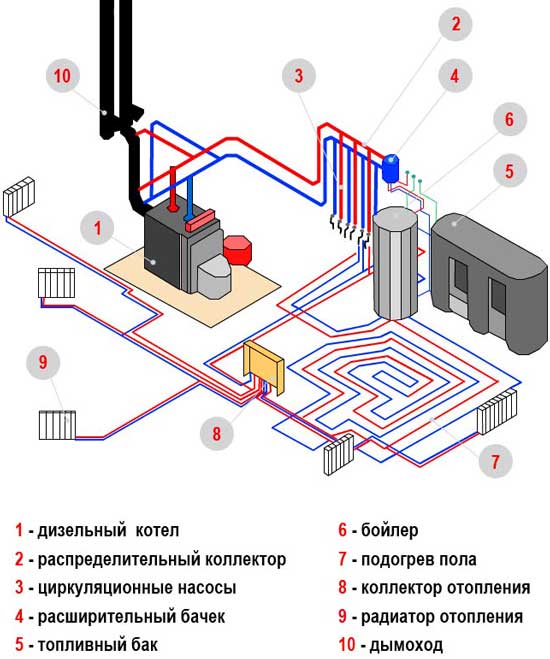
How to heat a frame house? Options for heating a wooden house can be considered at the design stage. Because they may require certain changes to be made to the finished project. The presence of a Russian stove or fireplace entails strengthening the foundation section over which their installation will be supposed.
But today, the use of an open fire stove for high-quality heating of a private house is hardly possible.
But heating a frame house with a fireplace exists, but for the most part in the form of a decorative element that gives the interior additional comfort. This can be explained by the fact that when heating with a fireplace, air plays the role of a coolant, and this is not a very good heat conductor.
The space in front of the fireplace warms up very strongly, while the whole house will be quite cool. This can also be attributed to the heating system of a frame house, the walls of which, due to their properties, will not retain enough heat. That is why the fireplace is considered only as another source of heating.
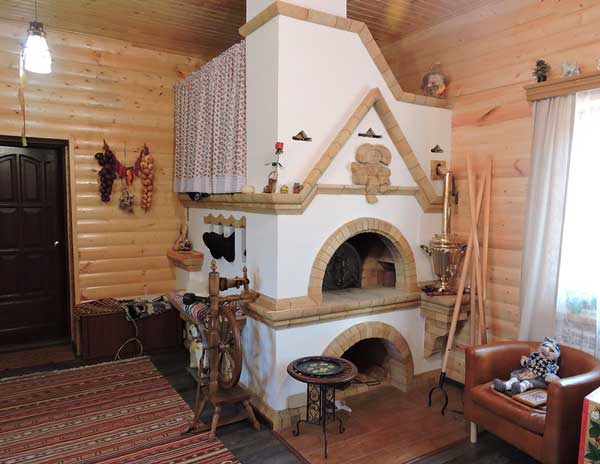
But in terms of its features and characteristics, the Russian stove is most suitable for heating a large residential wooden house, and most property owners will give their preference to more modern heating methods.
For example, such as:
- electric heating of the house;
- heating the house with gas;
- heating the house with water;
- air type heating.
Heating with electricity
Most often, heating a frame house with electricity surpasses other options in popularity. The installation of electrical appliances does not require additional permits, they do not depend on environmental conditions, and do not require additional consumables.
Electrical heating scheme.
An electric boiler is installed in accordance with the rules for installing other electrical equipment: all wiring in a frame house is calculated according to the power of the device with a margin and is securely insulated.
The following types of electric heating can be used in a frame house:
The warm floor in the frame house is installed on the subfloor. The surface must be covered with vapor barrier material. It will protect the floor from high humidity. A reflective material is laid on the prepared surface, which will prevent heat dissipation, thermal mats are laid above. The floor is finished, all system controls are installed.
Installation of a warm house.
The main advantage of a warm floor is the air heating of a frame house, warm air rises evenly from the floor and is distributed over the entire surface, cold air gradually sinks down, where it also heats up.
electric boiler
Installation of an electric boiler can be carried out without the involvement of specialists, while observing:
- Cross-section of wires, according to the technical documentation of the equipment.
- The switch is located in the same room as the boiler.
- If a boiler is used, then it is mounted above the electric boiler.
- All electrical wiring in a frame house is laid in advance
- During installation, the necessary safety rules are observed to avoid electric shock.
During the operation of the electric boiler, the absence of leaks and poor insulation is constantly monitored.
Electric underfloor heating in the bathroom
Electric space heating systems are excellent for any premises, including those in which the operation of a water heated floor is impossible or extremely difficult. Installation and installation of electric underfloor heating is quite simple in its execution, so anyone can handle it.
The bathroom is a room with a high level of humidity, thanks to which fungi that negatively affect your well-being have very good conditions for development. After installing a warm floor in the bathroom, the room becomes much drier, which reduces the likelihood of fungus to a minimum.
How to make a warm floor in the bathroom?
If you are confident in your abilities, you can familiarize yourself with the technology of installing a warm floor and proceed with the self-assembly of the system.
In fact, the electric floor heating system is a separate element from the main floor, which is mounted before or during the laying of the floor. This system includes heating cables or mats that are laid on a concrete base (or in the process of laying new tiles on the old), and then firmly glued to the old coating. Mats consist of fabric with heating elements woven into it, reliably protected and isolated from moisture. To connect to the mains, free wires about 4 meters long are connected to each mat from the beginning and end.
The system is powered by a 220V mains supply. Due to the built-in sensor, the temperature regime of the heated floor in the bathroom is measured, and the required heating is set using an electronic thermostat.
The wires of the temperature sensors and the supply wires are led into the pipes, after which the junction box is closed with a lid. The most optimal ways of cutting with the subsequent laying of thermomats are in the area of \u200b\u200bthe bathtub and the corners of the room. If necessary, small cutouts are made in the mats, trying to eliminate the possibility of damage to the heating elements.
Do not pinch, bend or cut wires. Mats should only be glued to a clean and dry base surface using a special tile adhesive. After the gluing is completed, you can start installing the underfloor heating in the bathroom with the further connection of all the necessary elements of the system.
Underfloor heating in the bathroom, reviews of which are positive in most cases, are an ideal solution for repairs, as they are designed for heating small rooms. Using the thermostat, you can set the desired temperature and maintain it in the right state throughout the day.

